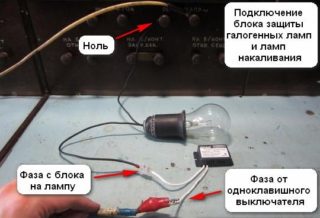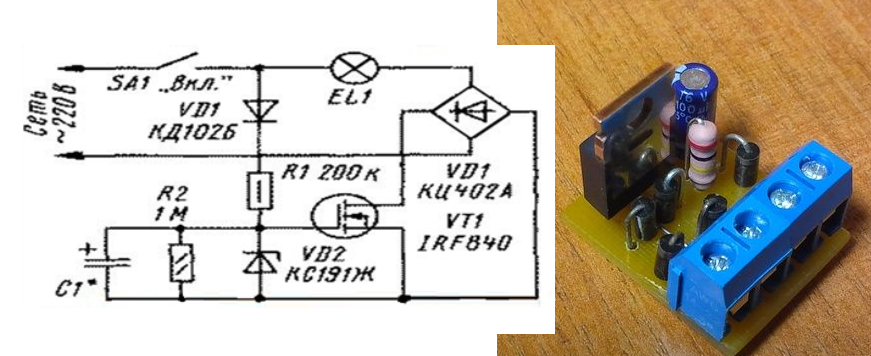LED lamps are becoming more and more popular, but despite this fact, incandescent lamps are still used by millions of people, largely due to their low retail cost. This category includes not only a traditional incandescent light bulb, but also halogen light sources with a GU4 or GU5.3 base.
- Causes of premature burnout
- Principle of operation
- Ready-made solutions
- Connection diagrams
- Smooth switching on of 220 V lamps: thyristor circuit
- Smooth switching on of lamps 220 V: circuit on a triac
- Circuit on a specialized microcircuit
- Connection using a protection box
- How to make a protection unit yourself
Causes of premature burnout

In the overwhelming majority of cases, incandescent lamps burn out when turned on, when the coil has the lowest electrical resistance. A cold filament has 10 times less resistance than a heated one. As a result, when the lamp is ignited, the current indicator reaches 8 A, which may turn out to be critical for a cold coil.
The UPVL will help to extend the operational life of the lighting source - smooth switching on of 220 V incandescent lamps, the circuit of which is simple. The task of such a device is to gradually increase the voltage across the load, sharp current surges in the first seconds after ignition are excluded. Smooth heating of the spiral makes it possible to increase the lamp life by 2-3 times, instead of the declared 1000 hours.
Principle of operation
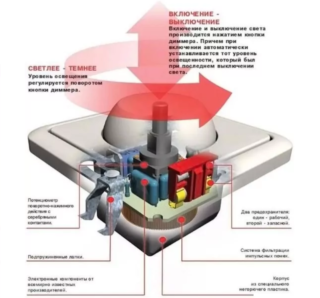
For a measured increase in the applied voltage, it is enough that the phase angle grows in just 2-3 seconds. The current surge is smoothed out, which contributes to the smooth heating of the spiral.
When the light bulb is lit, a half-wave of the negative type is fed through the diode, while the power indicator is equal to only half the voltage. The capacitor is charged in a positive half cycle. When the voltage indicator on it rises to the thyristor opening indicator, the full mains voltage is applied to the lighting source and it glows at full incandescence.
Ready-made solutions
There are a lot of UPVL from Russian and foreign brands that make it possible to implement a smooth light switch on. The cost of such devices directly depends on their functionality. Some models interact exclusively with incandescent bulbs, others additionally interact with halogen bulbs. Even budget models can withstand loads of up to 300 watts for a long time.
The gradual switching on of the light bulb can also be realized by means of a phase regulator. Its design is similar to the UPVL, but the control system is more complex and the regulator is capable of withstanding a large load. The dimensions of the device are set by the dimensions of the radiator, which removes heat from the power component of the circuit.
Each device, which guarantees the gradual ignition of incandescent lamps, is connected to the electrical circuit in series, in the break of the neutral wire or phase. The voltage in the load rises for a certain period of time, which is fixed and not adjustable. This time is set by the manufacturer and can be up to 3 seconds.
Connection diagrams
In order for the smooth ignition of the light bulb to be effective, a special wiring diagram is needed. With its help, you can understand how the UPVL functions and what is its internal structure.
Usually, when connecting such a device, the simplest thyristor circuits are used. A special circuit with an integrated triac is used somewhat less frequently.In addition to these blocks, field effect transistors can be used, which function similarly to gradual switching devices.
Smooth switching on of 220 V lamps: thyristor circuit
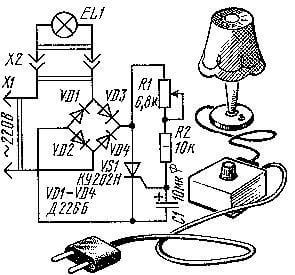
The thyristor circuit is simple and easy to make yourself.
The rectifier bridge circuit uses the lamp as load and current limiter. A shifting circuit and a thyristor are installed on the shoulders of the rectifier. The installation of a diode bridge is dictated by the specification of the thyristor functioning.
After applying voltage to the circuit, the current begins to pass through the filament and comes to the bridge, while the electrolyte is charged with a resistor in the meantime. It starts to open when the thyristor voltage limit is reached, after which the current from the lamp passes through it. As a result, the tungsten filament heats up smoothly. The time it warms up directly depends on the capacitance of the capacitor and the resistor built into the circuit.
Smooth switching on of lamps 220 V: circuit on a triac
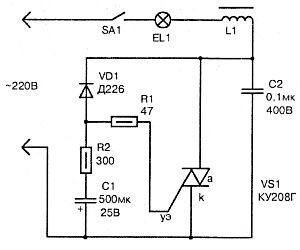
This circuit has fewer components due to the use of a triac as a power switch.
The choke, designed to eliminate various interference when opening the power switch, can be removed from the general network. The current flowing to the main electrode is limited by a resistor. The time-setting circuit is implemented on a capacitor and a resistor, which are powered by a diode.
The presented scheme functions similarly to the previous one. The capacitor opens when it is charged to the value of the opening voltage of the triac, and then the current flows through it to the lamp.
Circuit on a specialized microcircuit
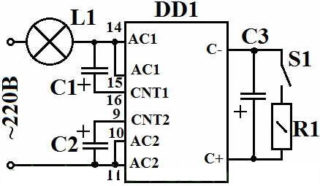
To create a regulator for the smooth ignition of lamps, you can use a special marking chip kr1182pm1.
In this design, the microcircuit itself regulates the voltage on the lamp with a filament with a power of up to 150W. To control a higher load, a larger number of lighting fixtures, an auxiliary power triac must be included in the control circuit synchronously.
These devices are capable of smoothly turning on not only incandescent bulbs, but also halogen ones at 220 V. Phase regulators are also installed in an electric tool, they smoothly start the motor armature, significantly extending the operating life of the devices.
It is strictly forbidden to install a dimmer for an incandescent lamp in conjunction with fluorescent and LED lamps. Their operating principle and circuitry are completely different. Each of these lamps has its own gradual heating device.
Connection using a protection box
If lamps for 220 V are used in lighting fixtures, the protection unit is connected to the circuit in a sequential manner. The polarity of the wiring does not matter, the main thing is that the unit must be connected to a wire break with a phase, that is, in series with the switch.
If the lamps used have a lower voltage (6-24 V) and are connected to the network by means of a step-down transformer, the protection unit must be connected from the input side of 220 V.
How to make a protection unit yourself
You can create a protection block according to the following scheme:
The principle of the block functioning:
- At the start, the field-effect transistor is in a closed state. It receives a stabilization voltage. The light is off.
- Resistor (R1) and diode (VD1) supply voltage to capacitor (C1), which causes it to charge up to 9.1 V. This is the limit, limited by the characteristics of the zener diode.
- When the set voltage is reached, the transistor starts to open, and the current increases. In the current state, the voltage will decrease, and the spiral of the light bulb will begin to gradually warm up.
- The discharge level of the capacitor is controlled by a second resistor. Due to this, the capacitor continues to discharge after the power is disconnected.
The use of a protection unit makes it possible to perform a gradual start-up of lamps with a filament. It protects them from negative flicker during operation.

